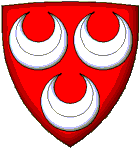 |
 |
 |
 |
 |
 |
| OLIPHANT, Laurence first Lord (abt. 1435-1499) |
| Top |
| *The above excerpt is from the Scots Peerage. Script in red indicates alterations as a result of newer evidence found. |
| Laurence Oliphant, the eldest son (of Sir John), was under age at his fathers death. The King in 1450 granted his ward and marriage to Sir David Hay of Yester. According to Boece he was one of those who accompanied the Earl of Douglas to Flanders, France, and Rome in 1450-51. In 1460 he is said to have founded a moastery of 'Observantine' Franciscans at Perth; but the date given is evidently too early. He was knighted before 29 June 1461, on which day he granted a discharge to the burgesses of Perth for the downcasting of the house of Dupplin and other outrages; an incident perhaps of the dispute about Tay fishings (concerning his father Sir John). He was created LORD OLIPHANT by July 1455, a month after he reached his majority. Thereafter he appears frequently in Parliament, and took a leading part in public affairs. He was Sheriff of Perth 1470 and 1471; appears on the sederunts of the Lords of Council as a judicial body from 1479 onwards; and was appointed one of the Lords Auditors of the Causes in Parliament 26 March 1482, and in several subsequent Parliaments. In 1484 he was one of the ambassadors who negotiated a peace with England and a marriage between Prince James (afterwards James IV) and the Lady Anna, only daughter of John, Duke of Suffolk. After the accession of James IV he sat on the tribunal which tried the partisans of the late King, and was appointed to try and punish criminals in the lowlands of Perthshire, Strathbraan, and the bishopric of Dunkeld; and was collector of the King's rents of Methven, and within the Sheriffdom of Perth. He had a safe-confuc as ambassador to England 26 February 1490-91; and another 14 June thereafter as ambassador to France and Spain. In that month his brother James of Archellie was slain in a feud with the Earl of Buchan, as has been already stated; the feud was ended by a contract of Assythment, 3 April 1492, and Lord Oliphant used the satisfaction money paid by the Earl to found two chaplainaries in the Church of Aberdalgie. He obtained the office of Bailie of the Abbey of Inchaffray 25 January 1468-69, and that of Bailie of the Nunnery of Elcho 5 December 1470. But his importance is best shown by the numerous bonds of manrent granted to him by his neighbours, fifteen of which are preserved in the Gask Charter-chest. His last recorded appearance is on the sederunt of the Lords of Council on 1February 1498-99; and he died before 8 April 1500. Lord Oliphant married, first, a daughter of William, first Earl of Errol (her Christian name is given in the peerages as Isabel). They had from Pope Sixtus IV a grant of a portable altar, 20 May 1472. Issue: 1) John, second Lord Oliphant 2) William, who married about 1489 Christian Sutherland, daughter and heir of line of Alexander Sutherland of Duffus. A long lawsuit with the heir-male, who disputed her legitimacy, ended about 1507 in a compromise, she and her husband obtaining the Caithness lands and those of Strabrock in West Lothian, and relinquishing all claim to the lands in Moray. William was usually styled of Berriedale; he died about 1508. His wife survived him, and married, secondly, Sir Thomas Lundin of Pratis, grandson and heir-apparent of Sir John Lundin of that Ilk. 3) Laurence, who was appointed Abbot of Inchaffray by the Pope, 16 November 1495. His paternity is proved by an Indenture between John, Lord Oliphant, and the Abbot on Inchaffray, his brother, dated 27 June 1502. He appears on the sederunts of the Lords of Council frequently between December 1505 and March 1506-07. He fell at the battle of Flodden. 4) George of Balmakorne. He was alive 11 August 1526, and died before 24 January 1527-28, when Andrew Oliphant of Berriedale had precept of clare constat as his heir from Alexander, Master of Crawford. 5)Margaret, contracted to George, Master of Angus, in 1485; which marriage does not appear to have taken effect. She is possibly the same Margaret Oliphant who in 1496 was the wife of Sir John Elphinstone of Airth, father of the first Lord Elphinstone. Lord Oliphant married secondly, Elizabeth, daughter of Sir Humphrey Cuninghame of Glengarnock, by who, who survived him and was married, secondly, to the above mentioned Sir John Elphinstone of Airth, he does not appear to have had any issue. References to Lords Oliphant in 1395 and 1408, whilst possibly wrong, suggest that the creation of the peerage may be earlier than previously supposed, adding another four Lords to the dynasty (the same has happened with the Saltoun Lordship, theirs was supposed to have been created in 1445. It is now is known to have been in existence since 1411). Premature deaths and imprisonment in England, meant that the relevant generations of Oliphants are not thought to have voted in Parliaments. Further research is required to clarify the position. |

